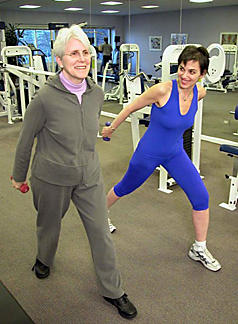Cancer Exercise Programs
Studies show that about one third of cancer deaths each year are related to an unhealthy diet and not enough exercise. On the other hand, not smoking, eating well, and getting plenty of exercise are the most important things we can do to prevent cancer.
 Cancer Exercise programs can help to control your weight and stabilize hormones. The same 30 minutes of moderate exercise a day that reduces your risk of heart attack by 50% can also reduce risk breast and colon cancer.
Cancer Exercise programs can help to control your weight and stabilize hormones. The same 30 minutes of moderate exercise a day that reduces your risk of heart attack by 50% can also reduce risk breast and colon cancer.
 Controlling your weight helps to reduce the risk of breast, colon, endometrium, esophagus, and kidney cancers. Healthy low fat diet of fiber, fruits and vegetables is also a major factor in reducing cancer risk.
Controlling your weight helps to reduce the risk of breast, colon, endometrium, esophagus, and kidney cancers. Healthy low fat diet of fiber, fruits and vegetables is also a major factor in reducing cancer risk.
Cancer Exercise Programs
Easy aerobic exercise has been shown to increase hemoglobin levels, reduce inflammation, lessen fatigue, and keep muscles in shape for better every day activities. Also you can increase self confidence, reduce depression and aid in recovery of surgery. Here are some aerobic exercise suggestions.
Other research has shown cancer exercise programs that involve strength and flexibility exercises have helped patients return to a normal activity level sooner.
Skin cancer is the most commonly diagnosed kind of cancer and lung cancer is the leading cause of cancer deaths among all Americans. Using sunscreen and not smoking make these two cancers largely preventable.
For women, the second most deadly cancer is breast cancer, third is colorectal cancer. Among women’s reproductive cancers, cancer of the endometrium – the tissue lining the uterus – is the most commonly diagnosed, followed by ovarian, vaginal, and vulvar cancers.
Breast cancer. Age and hormones play a big role in prevention of reproductive cancers in women. The hormone estrogen (and subtypes, such as estradiol) has a lot to do with breast cancer, although scientists are still exploring why. New research studies are finding that young girls who get plenty of exercise and eat calcium and soy foods may have lower risk for breast cancer later in their lives. Pre-menopausal women have lower risk if they have had children and breast-fed children; for this age group, being overweight seems not to be as great a breast cancer risk as it is for post-menopausal women who gain weight. Weight gain also adds risk of recurrence for overweight breast cancer survivors.
Exercise and social support seem to increase the life expectancy of breast cancer survivors, preventing recurrence. Monthly self-exams and annual mammograms are vital in detecting breast cancer early enough to treat it, so that a patient’s survival is as great as possible. More exacting screening methods, including sentinel node biopsies (removal of small bits of tissue likely to reveal cancer) and mammograms better able to penetrate dense breast tissue that can hide cancer, are improving detection and making earlier treatment and longer survival possible. Breast cancer symptoms include:
• Lump or thickening of the breast
• Breast pain
• Dimpling or puckering of the skin
• Change in skin color or texture
• Change in breast shape
• Swelling redness or heat
• Discharge from or retraction of the nipple
• Scaly skin on or around the nipple
Cervical/Uterine Cancer. Cervical cancer is one of the few types of cancer (liver cancer is another) that develops as the result of a virus. PAP smear tests to detect cervical cancer have been greatly improved in the past few years. Regularly getting a PAP smear is the best method of detecting cervical cancer. Abnormal bleeding, especially in post-menopausal women, may be a sign of these cancers, but may also be a sign of other disorders that are not cancer. Premenopausal women may have heavier than normal bleeding. Pelvic pain (except cramping) and urination difficulties also are possible symptoms.
Ovarian Cancer. Ovarian cancer is difficult to detect before it has spread to a stage where it is usually fatal. Symptoms may include constant abdominal bloating and gas in the digestive system. Other symptoms may be the same as for cervical/uterine cancer, described in the previous paragraph.
Cancer treatments are improving. Although the side-effects of surgery, chemotherapy and radiation can still be devastating and very unpleasant, all of these therapies are being more finely tuned and made less dangerous as better technology is developed. More studies are showing effective combination treatments. Many cancers are becoming more manageable over a long-term with healthy habits and watchfulness, instead of the automatic death sentence they used to be. However, some hard-to-detect cancers, including ovarian and pancreatic cancer, have often spread too far before they can be treated.
So now may be the time to try some health coaching!
If you need some help, I have your back! Here’s a short video about my Health Coaching Technique how I have helped my clients achieve a balanced and Healthy Life.
For more health and fitness information and at home exercise programs please visit www.mirabaiholland.com
EASE IN, BECOME MOBILE, GET STRONG, LIVE LONG! Healthy Life
Follow Mirabai Holland, Certified Health Coach & Certified Exercise Physiologist:
It is important to keep up with new developments in cancer treatment and other care options. Here are some reliable resources on cancer, exercise, nutrition & support for women:
National Ovarian Cancer Coalition
American Breast Cancer Association
American Institute for Cancer Research
National Women’s Health Foundation















